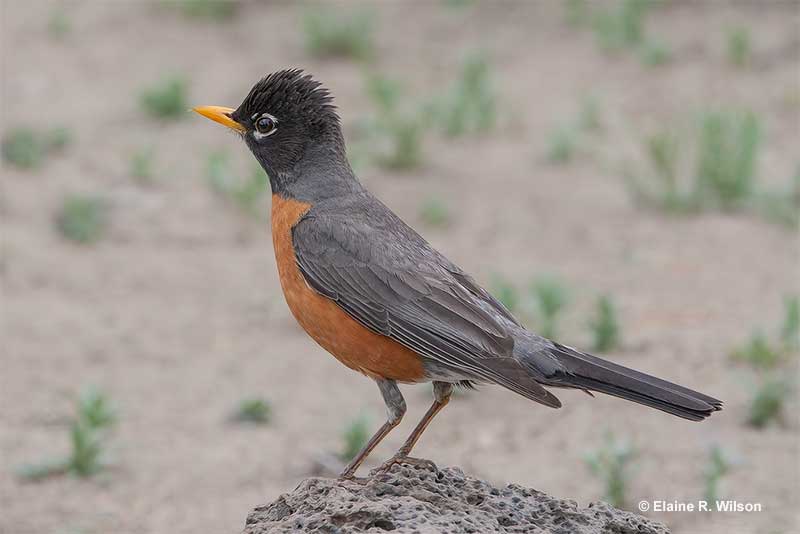
Wisconsin is a midwestern state with 65,498 square miles of forests, wetlands, and lots of lakes. This beautiful state is home to nearly 5.9 million people and more than 400 bird species!
Wisconsin state bird, however, is the beautiful American Robin. A common sight throughout the state, this dark gray thrush with brick-red underparts is also Wisconsin’s state bird.
On this page
Wisconsin State Bird
The American Robin became the Wisconsin state bird on June 4th, 1949. This is the date when the state legislature finally voted to make this common species an official state symbol.
However, this wasn’t the first time it had been picked to represent Wisconsin. More than twenty years earlier, schoolchildren in Wisconsin had already chosen the American Robin to be the state bird.
During the 1920s, as with many other states, local Federated Women’s Clubs in Wisconsin were working to have the state choose an official bird. As part of their campaign, in 1926 and 1927, they sponsored a statewide survey in Wisconsin schools and asked children to vote for the bird that would best represent the state.
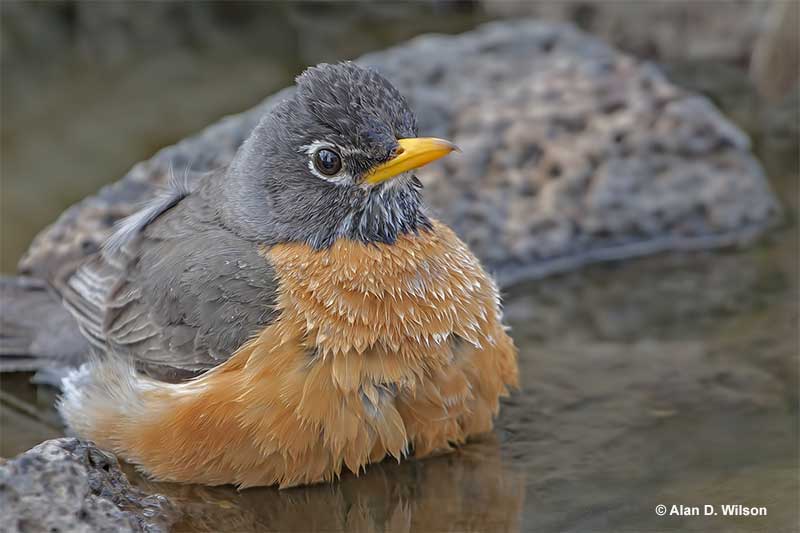
The clear winner was the American Robin, but the state legislature didn’t bother to have a vote on it. It took some convincing, but Mrs. Walter Bowman, the Women’s Clubs Conservation Chairperson, finally convinced the politicians to make it official in 1949.
Schoolchildren in Wisconsin surely picked this bird to represent their state because they were very familiar with it. In Wisconsin, American Robins are common and beautiful birds that live in gardens, towns, on farms, and other places. Not to mention, they also have a pretty, melodious song often associated with spring.
Fun Facts about American Robins
- American Robins are often seen as heralds of spring. However, in many parts of their range, they don’t migrate very far. Instead, these beautiful birds form flocks that winter on farms and in woodlands in the countryside.
- Robins that breed in Alaska and northern Canada can migrate much further than birds breeding in the lower 48 states. These American Robins of the far north can migrate south all the way to Iowa, a distance of 3,000 miles!
- This species can have three different broods in a year. Even so, they nest so often because a large number of young robins don’t survive beyond their first year. Many fall prey to predators, while others don’t find enough food.
- Like some other species that eat berries, American Robins sometimes become intoxicated from eating fermented fruit!
- Although it was named after the European Robin, the American Robin is not related to that Eurasian species. Both have a similar red-orange color on their underparts, but American Robins are in the thrush family. The European Robin is actually an “Old World Flycatcher”.
- The fact that American Robins are common birds is often taken for granted. However, during the mid-20th century, large numbers died from DDT poisoning. Since then, their numbers have rebounded. However, in some areas, pesticide use on lawns continues to cause local declines.
- Wisconsin isn’t the only state that has chosen this lovely bird as their state bird. Michigan and Connecticut have the American Robin as their state bird as well!
Identification
American Robins are fair-sized songbirds with orange-yellow beaks. On average, these thrushes are 10 inches long, have a 17-inch wingspan, and weigh 2.7 ounces. Both sexes are similar in size but differ in other ways.
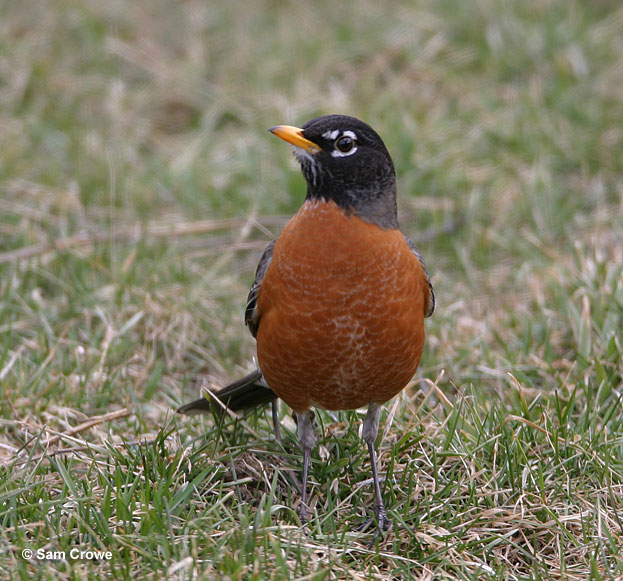
Male American Robins have blackish heads with bold white markings around their eyes and some white marks on their throats. The rest of the upperparts are dark gray, and they have some black edging to the feathers of their longish wings.
These pretty birds have brick-red on most of their underparts along with white on their belly and undertail. They also have medium-length, blackish tails with a bit of white on the outer tail feathers.
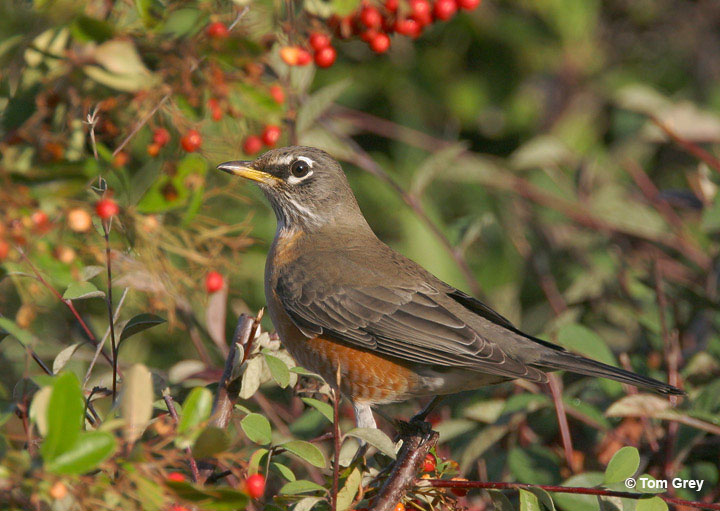
Female American Robin
Female American Robins can look similar to males. They have the same overall plumage pattern but are paler. Some are just a little bit paler, but some are so pale, they almost look like a different species. These pale female robins tend to have a white throat, white eyebrows, and pale edging on their wings.
Young birds look like females but with lots of dark spotting below and some pale markings above.
All American Robins have fairly quick and direct flight. In fall and winter, they often flock together.
What do American Robins eat?
American Robins eat worms, insects, snails, other small creatures, and fruit. Since they vary their diet according to what’s available, these thrushes feed much more on worms and bugs during warm months. During fall and winter, flocks move around in search of fruiting bushes and trees.
They mostly forage for worms and insects by standing on lawns and other similar places with open ground. They carefully keep watch for a worm or insect and then quickly run to snatch it with their beak. If the American Robin doesn’t notice prey, it moves forward to another spot.
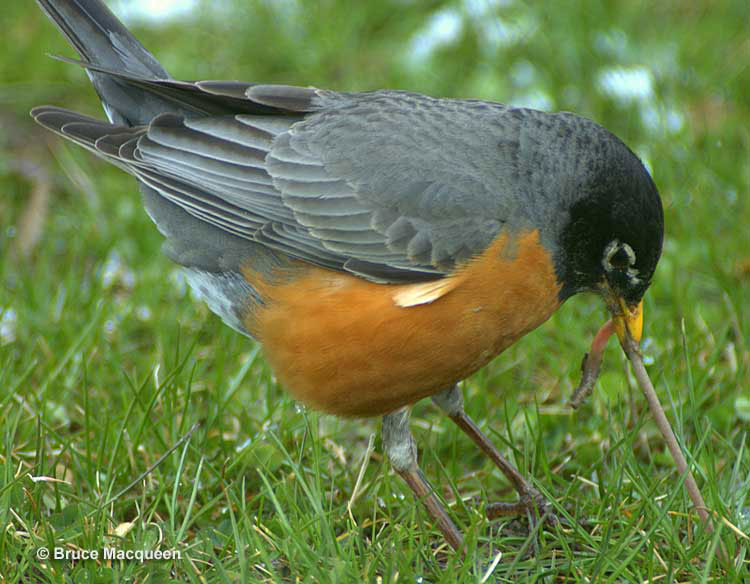
When foraging for bugs and worms, American Robins are usually on their own or in pairs. If another robin invades their feeding territory, they drive the new bird away. In fall and winter, though, they group together, often in big flocks.
These flocks of robins move together in search of fruiting plants. Some of the more common species they feed on include Honeysuckle, Hawthorn, Juniper, and Chokecherry. However, they can also eat crabapples and many other fruits and berries.
When the robins find a fruiting tree, they descend onto it and perch as they pick the fruits with their beaks. However, they can also pick up berries and fruit that have fallen to the ground.
Call
Male American Robins sing a friendly and melodious song. It consists of a grouping of five to seven repeated short, flute-like or whistled phrases. Their song can vary but typically sounds like, “plurit plurah keewah kiwit pluruh”.
Both sexes make clucking, laugh-like calls, and a loud, sharp call, “yink”. They also have a call of several rapid, “yink” sounds, and give a high-pitched “seeyut” call in flight.
Behavior
In spring, American Robins sing and form pairs, and nest shortly after. They can nest two or three times during the summer months and are often seen foraging on lawns for worms and bugs. At this time of year, they also become very territorial and pairs frequently chase other robins from their feeding grounds.
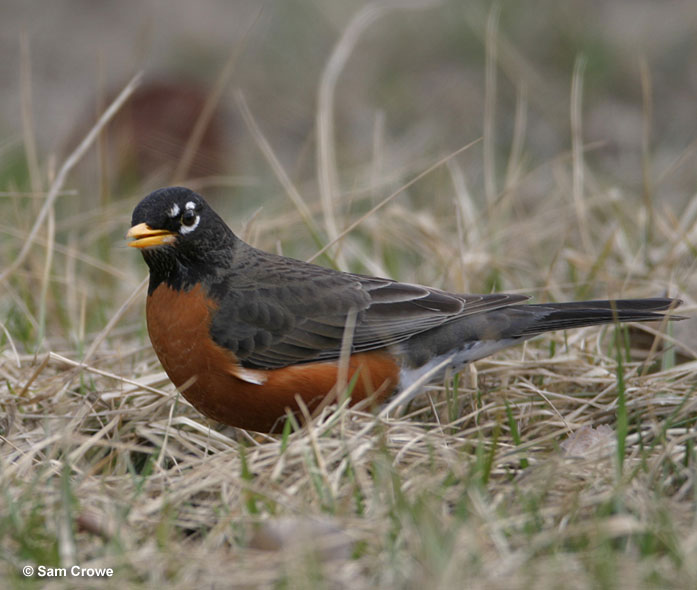
By fall, robins form flocks that wander in search of fruiting bushes and trees. Some can migrate to other states or even further. However, in much of the USA, most robins spend the winter close to their breeding grounds.
In winter, they have to be especially careful to avoid Cooper’s Hawks and various other raptors that prey on them.
What Other Birds Can You See In Wisconsin?
Wisconsin has a solid bird population with over 400 species. Here are some of the more common ones.
- Black-capped Chickadee
- American Crow
- Northern Cardinal
- American Goldfinch
- Blue Jay
- American Robin
- Mourning Dove
- Downy Woodpecker
- White-breasted Nuthatch
Read more – Most common birds – hawks – owls in Wisconsin
Frequently Asked Questions
What is the state bird of Wisconsin?
The state bird of Wisconsin is the American Robin.
Why is the American Robin the state bird of Wisconsin?
The American Robin is the state bird of Wisconsin because it is a common, easily recognizable, appreciated, and beautiful bird.
When did Wisconsin choose its state bird?
Wisconsin chose its state bird in 1927. However, the state legislature didn’t make it official until June 4th, 1949.
What other states have the American Robin as their state bird?
Other states that have the American Robin as their state bird are Connecticut and Michigan.
What is Wisconsin’s state animal?
Wisconsin’s state animal is the Badger.
What is the state flower of Wisconsin?
The state flower of Wisconsin is the Wood Violet.

